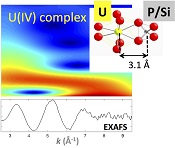 | Mononuclear U(IV) complexes and ningyoite as major uranium species in lake sediments Abstract: Natural attenuation of uranium in subsurface environments is generally assigned to immobilisation processes due to microbial reduction of U(VI). Recent laboratory studies have established that the end products of such a process include both low solubility biogenic uraninite and more labile non-crystalline U(IV) species. Indeed, biogenic uraninite formation may be inhibited in the presence of organic or inorganic phosphoryl ligands, leading to the formation of non-crystalline U(IV)-phosphate complexes or nanoscale U(IV)-phosphate solids. Such species have been observed in shallow contaminated alluvial aquifers and can thus be suspected to form in other important environments, among which lacustrine sediments have a global environmental significance since they may represent major uranium accumulation reservoirs in riverine watersheds. Here, on the basis of microscopic, spectroscopic and chemical extraction analyses, we report the occurrence of mononuclear U(IV)-phosphate/silicate complexes, accompanied by nano-crystalline ningyoite-like U(IV)-phosphate minerals, as major scavengers for uranium in lacustrine sediments downstream from a former uranium mine in France. This observation reveals that uranium trapping mechanisms during early diagenesis of lacustrine sediments can virtually exclude uraninite formation, which has important implications for better modelling uranium cycling in natural and contaminated freshwaters. Moreover, our results raise issues concerning the long term fate of mononuclear U(IV) complexes and U(IV) phosphate nano-minerals, especially with respect to re-oxidation events. |
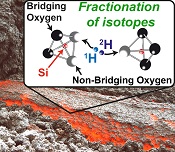 | Intramolecular fractionation of hydrogen isotopes in silicate quenched melts Abstract: The interplay between the chemical composition and the molecular structure of silicate melts was central to the evolution of the Earth’s crust, mantle and core. This interplay also affects geochemical records such as the partitioning of isotopes between minerals, melts and fluids in the Earth’s interior. For instance, large 2H/1H fractionations between silicate melts and aqueous fluids have been observed at high temperature and pressure. Such behaviour may be promoted by the occurrence of 2H/1H intramolecular fractionation within the molecular structure of silicate melts. New Raman spectroscopy and 1H and 2H Nuclear Magnetic Resonance (NMR) spectroscopy data reveal the source of such 2H/1H intramolecular isotopic fractionation, showing that 1H and 2H fractionate between the silicate tetrahedral units. Such a process might affect other isotopic systems (e.g., N, C, or S) where the isotopes interact with the melt silicate network. |
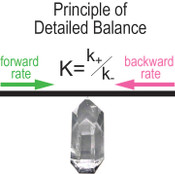 | A stable isotope doping method to test the range of applicability of detailed balance Abstract: The principle of detailed balance (PDB) has been a cornerstone for irreversible thermodynamics and chemical kinetics for a long time (Wegscheider, 1901; Lewis, 1925; Onsager, 1931), and its wide application in geochemistry has mostly been implicit and without experimental testing of its applicability. Nevertheless, many extrapolations based on PDB without experimental validation have far reaching impacts on society’s mega environmental enterprises. Here we report an isotope doping method that independently measures simultaneous dissolution and precipitation rates and can test this principle. The technique reacts a solution enriched in a rare isotope of an element with a solid having natural isotopic abundances (Beck et al., 1992; Gaillardet, 2008; Gruber et al., 2013). Dissolution and precipitation rates are found from the changing isotopic ratios. Our quartz experiment doped with 29Si showed that the equilibrium dissolution rate remains unchanged at all degrees of undersaturation. We recommend this approach to test the validity of using the detailed balance relationship in rate equations for other substances. |
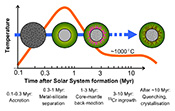 | Rapid cooling of planetesimal core-mantle reaction zones from Mn-Cr isotopes in pallasites Abstract: Pallasite meteorites, which consist of olivine-metal mixtures and accessory phosphates crystallised from silico-phosphate melts, are thought to represent core-mantle reaction zones of early differentiating planetesimals. Pallasite meteorites can be linked to five distinct planetesimals, indicating that they are default products of differentiation. However, their formation modes (deep, shallow, and impact environments) and age are still elusive. We have investigated the trace element and Mn-Cr isotopic signatures of Main-Group pallasite olivine, finding enhanced Mn, P and 53Cr/52Cr near crystal rims which indicates early ingrowth of radiogenic 53Cr* in silico-phosphate melts. Mn-Cr isotopic data corroborate previous Hf-W isotopic data, indicating an early metal-silicate separation event but additionally that rapid cooling generated silico-phosphate eutectic melts with high Mn/Cr within ~2.5 to 4 Myr of Solar System formation. These melts formed before most known samples of planetesimal crusts (eucrite and angrite meteorites) and are among the earliest evolved planetary silicates. Additionally, Mn-rich phosphates in other, non-Main-Group pallasite meteorites suggest that core-mantle reaction zones are generic, datable features of differentiation. |
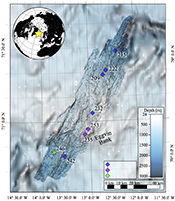 | North Atlantic hotspot-ridge interaction near Jan Mayen Island Abstract: At slow to ultraslow spreading rates along mid-ocean ridges, thicker lithosphere typically impedes magma generation and tectonic extension can play a more significant role in crustal production (Dick et al., 2003). The source of anomalously high magma supply thus remains unclear along ridges with ultraslow-spreading rates adjacent to Jan Mayen Island in the North Atlantic (Neumann and Schilling, 1984; Mertz et al., 1991; Haase et al., 1996; Schilling et al., 1999; Trønnes et al., 1999; Haase et al., 2003; Mertz et al., 2004; Blichert-Toft et al., 2005; Debaille et al., 2009). Here we show that Jan Mayen volcanism is likely the surface expression of a small mantle plume, which exerts significant influence on nearby mid-ocean ridge tectonics and volcanism. Progressive dilution of Jan Mayen geochemical signatures with distance from the hotspot is observed in lava samples from the immediately adjacent Mohns Ridge, and morphological indicators of enhanced magma supply are observed on both the Mohns Ridge and the nearby Kolbeinsey Ridge, which additionally locally overlies a highly heterogeneous, eclogite-bearing mantle source. These morphological and geochemical influences underscore the importance of heterogeneous mantle sources in modifying melt supply and thus the local expression of tectonic boundaries. |
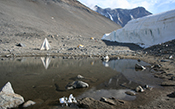 | Processes controlling carbon cycling in Antarctic glacier surface ecosystems Abstract: Glacier surface ecosystems, including cryoconite holes and cryolakes, are significant contributors to regional carbon cycles. Incubation experiments to determine the net production (NEP) of organic matter in cryoconite typically have durations of 6-24 hours, and produce a wide range of results, many of which indicate that the system is net heterotrophic. We employ longer term incubations to examine the temporal variation of NEP in cryoconite from the McMurdo Dry Valleys, Antarctica to examine the effect of sediment disturbance on system production, and to understand processes controlling production over the lifetimes of glacier surface ecosystems. The shorter-term incubations have durations of one week and show net heterotrophy. The longer term incubations of approximately one year show net autotrophy, but only after a period of about 40 days (~1000 hours). The control on net organic carbon production is a combination of the rate of diffusion of dissolved inorganic carbon from heterotrophic activity within cryoconite into the water, the rate of carbonate dissolution, and the saturation of carbonate in the water (which is a result of photosynthesis in a closed system). We demonstrate that sediment on glacier surfaces has the potential to accumulate carbon over timescales of months to years. |
 | Carbon isotope discrimination in C3 land plants is independent of natural variations in pCO2 Abstract: The δ13C of terrestrial C3 plant tissues and soil organic matter is important for understanding the carbon cycle, inferring past climatic and ecological conditions, and predicting responses of vegetation to future climate change. Plant δ13C depends on the δ13C of atmospheric CO2 and mean annual precipitation (MAP), but an unresolved decades-long debate centres on whether terrestrial C3 plant δ13C responds to pCO2. In this study, the pCO2-dependence of C3 land plant δ13C was tested using isotopic records from low- and high-pCO2 times spanning historical through Eocene data. Historical data do not resolve a clear pCO2-effect (-1.2 ± 1.0 to 0.6 ± 1.0 ‰/100 ppmv). Organic carbon records across the Pleistocene-Holocene transition are too affected by changes in MAP, carbon sources, and potential differential degradation to quantify pCO2-effects directly, but limits of ≤1.0 ‰/100 ppmv or ~0 ‰/100 ppmv are permissible. Fossil collagen and tooth enamel data constrain pCO2-effects most tightly to -0.03 ± 0.13 and -0.03 ± 0.24 ‰/100 ppmv between 200 and 700 ppmv. Combining all constraints yields a preferred value of 0.0 ± 0.3 ‰/100 ppmv (2 s.e.). Recent models of pCO2-dependence imply unrealistic MAP for Cenozoic records. |
 | Tracing Earth’s O2 evolution using Zn/Fe ratios in marine carbonates Abstract: Through Earth history, atmospheric oxygen has increased from initial values near zero to its present day level of about 21 % by volume; concomitantly, changes in ocean redox conditions have fundamentally altered global biogeochemical cycles. While there is a reasonable understanding of where oxygen history begins and ends, the quantitative timetable of oxygenation that links the endpoints has proven contentious. Equilibrium between marine surface environments and the overlying atmosphere suggests that carbonate-based redox proxies could refine palaeoredox records in time and space. Here we explore the use of Zn/Fe ratios to infer the evolution of atmospheric O2 through time, based on marine carbonate rocks that are well characterised in terms of depositional age, environmental setting, and diagenetic history. While Fe and Zn in the shallow ocean are mainly sourced from hydrothermal inputs, their redox sensitivities differ significantly, so that geological intervals with higher O2 would be characterised by stepped increases in Zn/Fe as preserved in shallow marine carbonates. Therefore, Zn/Fe analyses of ancient carbonates allow us to constrain past atmospheric pO2 levels, providing a secular record of atmospheric O2 over the past 3.5 billion years. In particular, we corroborate an earlier proposal that for much of the Proterozoic Eon, O2 levels were as low as 0.1-1 % of present atmospheric level. We conclude that Zn/Fe in shallow marine carbonate rocks has potential to provide a quantitative tracer for the long-term redox evolution of the oceans and the rise of atmospheric O2. |
 | A cometary origin for martian atmospheric methane Abstract: Methane has been reported repeatedly in the martian atmosphere but its origin remains an obstinate mystery. Possible sources include aqueous alteration of igneous rocks, release from ancient deposits of methane/water ice clathrates, infall from exogenous sources such as background interplanetary dust, or biological activity. All of these sources are problematic, however. We hypothesise that delivery of cometary material includes meteor outbursts, commonly known as “meteor showers”, may explain martian methane plumes. Correlations exist between the appearance of methane and near-approaches between Mars and cometary orbits. Additional correlations are seen between these interactions and the appearance of high-altitude dust clouds on Mars, showing that large amounts of material may be deposited on Mars during these encounters. Methane is released by UV breakdown of delivered cometary material. This hypothesis is testable in future Mars/cometary encounters. A cometary origin for methane would reveal formation of methane through processes that are separate from any geological or biological processes on Mars. |
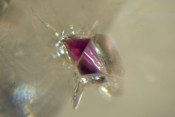 | The pyroxenite-diamond connection Abstract: Pieces of the Earth’s mantle occurring either as tectonic fragments or xenoliths in volcanic rocks are dominantly peridotites, assemblages of olivine, ortho- and clinopyroxene with minor garnet and/or spinel. They frequently contain pyroxene-rich inclusions which have compositions intermediate between peridotite and basalt. These pyroxenites typically contain varying amounts of more iron-rich (than peridotite) clinopyroxene, orthopyroxene, garnet and/or spinel and are commonly compositionally layered. Surprisingly, despite their subordinate abundance in mantle fragments, pyroxenitic compositions appear be the dominant sources of majoritic garnet inclusions in diamonds, the principal window into the mineralogy of the deep upper mantle and the transition zone (Kiseeva et al., 2013a). In this study we show that the pyroxenite-diamond association is a consequence of the interaction between basaltic and peridotitic compositions in the presence of carbonate melt and that layering of the pyroxenites is a natural consequence of this interaction. Reduction of carbonate to carbon at high pressures is responsible for the genetic connection between pyroxenite and diamond and the abundance of pyroxenitic inclusions reflects this connection rather than a high abundance of this rock type in the mantle. |
 | Molecular biosignatures in planetary analogue salts: implications for transport of organics in sulfate-rich brines beyond Earth Abstract: Salts formed during evaporation or freezing of brines can potentially incorporate organic matter that can inform about past biological activity. We analysed the lipid fraction preserved within the contemporary Lost Hammer salt deposit (Canadian High Arctic) - an analogue to extraterrestrial salt systems - and paired this with space mission-relevant evolved gas analysis. Our findings show microbial organic matter (fatty acids and n-alkanes) is incorporated into Lost Hammer salts, which comprise polyhydrated sulfates and chlorides. We find a difference in the relative abundance of fatty acids vs. n-alkanes indicating how these biosignatures evolve across active and non-active parts of the spring. We also find differences between pristine salt-organic mixtures and deposits that may have been remobilised by subsequent dissolution and recrystallisation. In this system, n-alkanes have the highest preservation potential, surviving the likely dissolution and recrystallisation of hydrated salt phases. This is important for considering the fate of organic matter on icy moons such as Europa, where salts emplaced on the surface by briny extrusions may have undergone fractional crystallisation, or where subsurface salts are remobilised by localised melting. It is also relevant for once active brine systems on Mars, where cycles of groundwater recharge and/or deliquescence led to dissolution and re-precipitation of evaporitic salts. |
<< Previous issueNext issue >>





